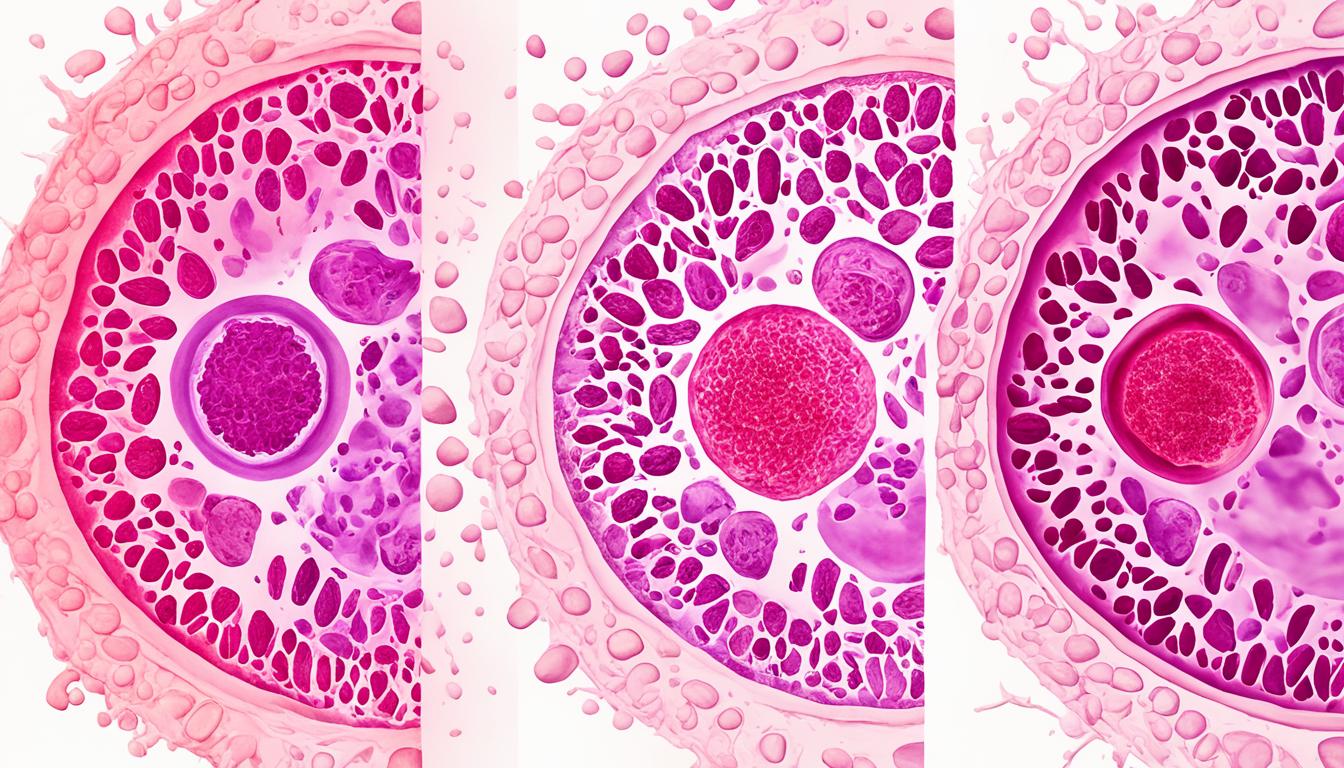Mastitis is a painful issue in cows. It affects their mammary glands. This can lead to less milk and money loss in the dairy business. Studies show it’s a big problem for farmers due to its effects on milk production and economics.
Cows with mastitis often have high somatic cell counts. They might benefit from vitamin E to control mastitis. Vitamin E link.
Current treatments, like antibiotics, have their limits. So, scientists are looking into stem cell therapy. It’s in the early stages but seems promising. This new approach could fight bacteria and help damaged tissue heal.
Key Takeaways:
- Mastitis is a common condition in cows that affects the mammary glands.
- Mastitis can cause decreased milk production and economic losses in the dairy industry.
- Research has explored the relationship between mastitis and somatic cell count and the role of vitamin E in controlling mastitis in dairy cows.
- Traditional treatments like antibiotics have limitations, leading to a need for alternative therapies.
- Stem cell therapy shows promise in killing bacteria and promoting tissue healing for mastitis treatment.
Cutting-edge Treatments for Mastitis
For years, antibiotics were the main way to treat mastitis. Now, concerns over antibiotic resistance have led to the search for new methods. Researchers are looking into treatment that doesn’t rely on antibiotics. They hope to find ways to prevent and control mastitis without these drugs.
- Immunotherapy: Harnessing the power of the immune system to fight mastitis and promote healing.
- Bacteriocins: Naturally occurring antimicrobial peptides produced by bacteria to kill other bacteria, which can be used as an alternative to antibiotics.
- Bacteriophages: Viruses that specifically target and kill mastitis-causing bacteria.
- Antimicrobial peptides: Short chains of amino acids with antimicrobial properties that can combat mastitis.
- Probiotics: Beneficial bacteria that can help restore the natural balance of the mammary gland and prevent mastitis.
- Native secretory factors: Substances naturally secreted by the mammary gland, which possess antimicrobial and immune-regulating properties.
These new treatments are designed to cut back on antibiotic use. They fight mastitis effectively with different approaches than before. As researchers discover more options, they’re fighting against bacteria that have become resistant to antibiotics. The goal is to make mastitis management better for everyone.
Stopping mastitis before it starts is also important. There are different ways to keep mastitis away, including:
- Dry cow therapy: Applying treatments during the dry period between lactations to eliminate existing infections and prevent new ones.
- Lactation therapy: Implementing veterinarian-approved treatments during lactation to promote udder health and prevent mastitis.
- Genetic selection: Breeding cows with genetic traits that make them less susceptible to mastitis.
- Nutritional interventions: Providing cows with optimal nutrition to bolster their immune system and reduce mastitis risk.
It’s key to stop mastitis before it starts. But, we also need new ways to treat it when it appears. Developing new treatments and methods is essential to manage mastitis and tackle antibiotic resistance.
| Treatment | Description |
|---|---|
| Immunotherapy | Utilizes the immune system to fight mastitis and promote healing. |
| Bacteriocins | Naturally occurring peptides that kill mastitis-causing bacteria. |
| Bacteriophages | Viruses that target and kill specific mastitis-causing bacteria. |
| Antimicrobial peptides | Short chains of amino acids with antimicrobial properties. |
| Probiotics | Beneficial bacteria that restore the natural balance of the mammary gland. |
| Native secretory factors | Substances naturally secreted by the mammary gland with antimicrobial properties. |
The Role of Genetics and Research Advances in Mastitis
Understanding mastitis in cows is key to fighting it. Genetic research helps us learn more and create better tools. Baker Institute for Animal Health and Elanco are working together. They are looking into using compounds from stem cells to treat mastitis. The project is funded by several groups and aims to find a new, natural way to fight mastitis without antibiotics.
A team at the University of New Hampshire and Cornell University has gotten a grant. They will study the genes of mastitis bacteria. This effort hopes to find better ways to prevent and treat mastitis, which costs the dairy industry a lot.
Thanks to groups that support farming research, like the Foundation for Food and Agriculture Research, we can push forward. Their help is crucial in the fight against mastitis. Genetic research combined with other efforts is our best bet to keep cows healthy and milk production up.

